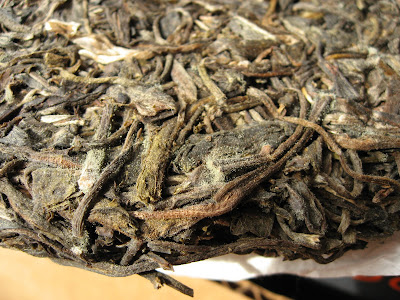Mold
It's the one thing that can go wrong with pu-erh. Mold is also one of the things responsible for pu-erhs maturation. So, while mold is good, it can also be bad, very bad. Yellow mold on pu-erh is said to be toxic, however, a light frosting of white mold is said to be beneficial. So, in short, mold development must be kept in balance.
Sadly, a few bings in my collection have developed mold. This mold has passed the beneficial point. It journeys into the realm of yellow pu-erh mold. Not only the color, but also the rate at which it has developed is a bad sign (in this case, under a year). Because of the lack of information on pu-erh on the web, especially in the field of mold development, I'm hoping this will be of interest and help to enthusiasts.
The story...
So, here's what happened. I made a storage cabinet for my puerh, with elevated RH levels in the 70-80% range. I got careless in opening it up for air exchange at one point, leaving it closed up for 3-7 days at a time. After a couple months of this, I found mold growing on one of my cakes. I checked most of them out, and about half are affected, this '06 Yongpinhao, for some reason, took the grunt of the burden...

Pu-erh mold starts on stems...
What's very interesting to note, is that the mold is essentially only growing on stems. Is this typical? Does pue-erh mold generally start on stems? Did the stems soak up more water from the air because they're, well, stems, and made to transfer water? Hard to know because of the miniscule amount of data out there. From what I can remember, I haven't seen mold exclusively on stems. Hobbes of the half-dipper posted this photo of moldy puerh (which he drank), which shows mold on the leaf. This seems typical to me. My other bings that have developed a lesser amount of mold, also show it almost exclusively on the stems. Bings from the cabinet that don't have many large stems showing, for example the 01 baoyan, don't have any mold.

So, for now I have opened up the cabinet to ensure good airflow, and removed humidifiers. The area is resting at just over 60%RH on average. For one very stemmy cake ('05 ming-yuan hao), I brushed off the mold from half of it with a toothbrush. The mold on that side hasn't returned, but the mold on the other side hasn't gone away either.

These pictures are all of the '06 Yongpinhao, which I will revisit in this entry. The mold on the other cakes isn't significant enough to photograph, and appears at most as a very light frosting on the cake, with some more significant development on the looser edges of the cake, again, only on the stems. My plan is to brush the mold off all of the affected, except for the ming-yuan, which I will watch closely to observe development. The Yongpinhao is not being subjected to a brushing, but to more air circulation, and light. While these aren't good for the tea, they'll hopefully take care of the mold, and it will be interesting to learn what it takes to get rid of the mold.
So what happened...
Over a few months, in a storage cabinet with no air flow for 3-7 days at a time, and 70-80%RH, raw sheng bings developed significant visible mold. Most with only minimal amounts, occurring mostly on the looser edges, and exclusively on stems. After being opened to free air flow, and resting in an RH just over 60% for a few weeks, the mold has not gone away, but has not increased either.
If you're curious about anything, feel free to shoot me an e-mail (address found at bottom of page).
2006 Yongpinhao Yiwu Zhengshan
I reviewed this tea a while back. My final thoughts were that I was very interested in how the strong lemon/zest and lumber flavors would develop over time. I've been interested in the storage of this cake ever since.
9 Months Later...

Because of the condition of this cake, I had to chip leaf off of the bottom, where there was less mold. I also rinsed it twice, just to be careful. But, to be honest, the mold doesn't scare me too much. Mold is what makes pu-erh better, or so I will tell myself.

So, I'm tasting this 9 months later, and I've noted some new things. First off, the color is much darker, an orange now. Quite amazing really. Compare the orange above to the yellow of this photo, taken 9 months ago:

In addition than the color, the tea has changed in multiple other ways. It now has a very noticeable mouthfeel; it's viscous, and sticks to the tongue and cheeks. I can still smell the lumber on the wet leaf, but I believe that it's a subjective scent. It took a moment for me to recognize the aroma as lumber. It was like it was hidden beneath the other aromas. The taste now is much sweeter. There's still a lot of orange/zest to it. Some smoke, but little bitterness if brewed with very short infusions (except when it has cooled off, then it is very bitter, and can be very bitter with longer infusions). Some astringency sticks to the throat, drying it out.
Now, I don't think this cake is of good quality. In fact, I find it to be pretty low. So, why do I like it? I enjoy the flavors it presents, especially the lumber and orange/zest, and am real interested in how these will change over the years. Puerhshop still has them in stock, for $17/400g, which is worth it to me. So, I think I'll buy another, and keep it mold free, but I'll keep this moldy one around to see what happens to it.
0 comments:
Post a Comment